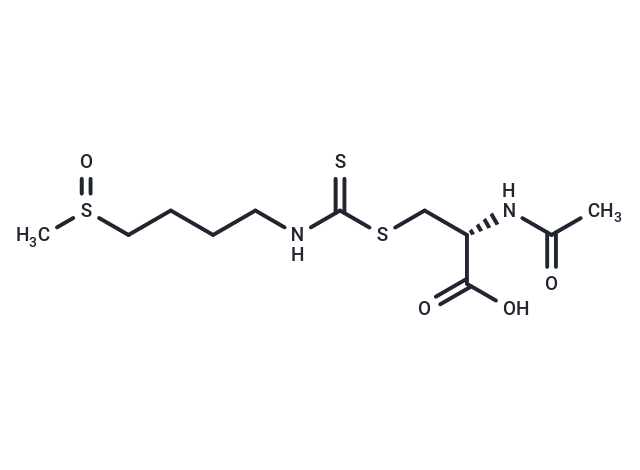Shopping Cart
Remove All Your shopping cart is currently empty
Your shopping cart is currently empty
DL-Sulforaphane N-acetyl-L-cysteine (SFN-NAC), a metabolite of sulforaphane, induces apoptosis through down-regulation of α-microtubulin and phosphorylation of ERK1/2-mediated Stathmin-1, and up-regulation of Hsp70 through phosphorylation of ERK1/2 in non-small-cell lung cancer (NSCLC).

| Pack Size | Price | USA Warehouse | Global Warehouse | Quantity |
|---|---|---|---|---|
| 1 mg | $199 | - | In Stock |
| Description | DL-Sulforaphane N-acetyl-L-cysteine (SFN-NAC), a metabolite of sulforaphane, induces apoptosis through down-regulation of α-microtubulin and phosphorylation of ERK1/2-mediated Stathmin-1, and up-regulation of Hsp70 through phosphorylation of ERK1/2 in non-small-cell lung cancer (NSCLC). |
| Targets&IC50 | HA cells:60.08 μM, U-373MG cells:39.11 μM, U-87MG cells:35.20 μM |
| In vitro | In studies on U87MG and U373MG cells, treatment with DL-Sulforaphane N-acetyl-L-cysteine (30 μM) for 24 hours resulted in cell cycle analysis showing drug-induced G2/M phase arrest, along with the initiation of apoptosis. In the same cell lines, Western blot analysis revealed that DL-Sulforaphane N-acetyl-L-cysteine, within a concentration range of 10 to 50 μM, activated ERK1/2 (Thr202/Tyr204), downregulated α-tubulin, and induced autophagy in a dose-dependent manner. Additionally, cell viability assays showed that DL-Sulforaphane N-acetyl-L-cysteine, within a concentration range of 0 to 90 μM, decreased the viability of HA cells, U87MG cells, and U373MG cells in a dose-dependent manner, with IC50 values of 60.08 μM, 35.20 μM, and 39.11 μM, respectively[1]. |
| In vivo | In the HDAC inhibition model, DL-Sulforaphane N-acetyl-L-cysteine (10 μmol, oral gavage, single dose, 6-hour treatment) significantly inhibited histone deacetylase (HDAC) activity in the colon mucosa of mice[2]. |
| Synonyms | SFN-NAC, SFNNAC |
| Molecular Weight | 340.48 |
| Formula | C11H20N2O4S3 |
| Cas No. | 334829-66-2 |
| Smiles | [C@@H](CSC(NCCCCS(C)=O)=S)(NC(C)=O)C(O)=O |
| Relative Density. | 1.371 g/cm3 (Predicted) |
| Storage | store at low temperature | Powder: -20°C for 3 years | In solvent: -80°C for 1 year | Shipping with blue ice/Shipping at ambient temperature. | ||||||||||||||||||||||||||||||
| Solubility Information | DMSO: 8 mg/mL (23.5 mM), Sonication is recommended. PBS (pH 7.2): 8 mg/mL (23.5 mM), Sonication is recommended. Ethanol: 4 mg/mL (11.75 mM), Sonication is recommended. DMF: 8 mg/mL (23.5 mM), Sonication is recommended. | ||||||||||||||||||||||||||||||
Solution Preparation Table | |||||||||||||||||||||||||||||||
Ethanol/DMSO/PBS (pH 7.2)/DMF
DMSO/PBS (pH 7.2)/DMF
| |||||||||||||||||||||||||||||||
| Size | Quantity | Unit Price | Amount | Operation |
|---|

Copyright © 2015-2025 TargetMol Chemicals Inc. All Rights Reserved.